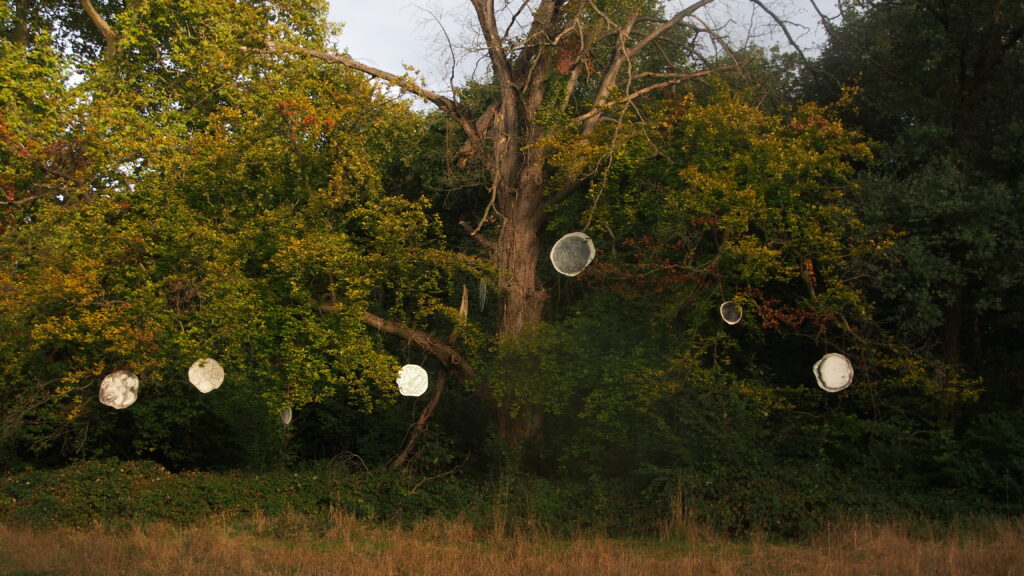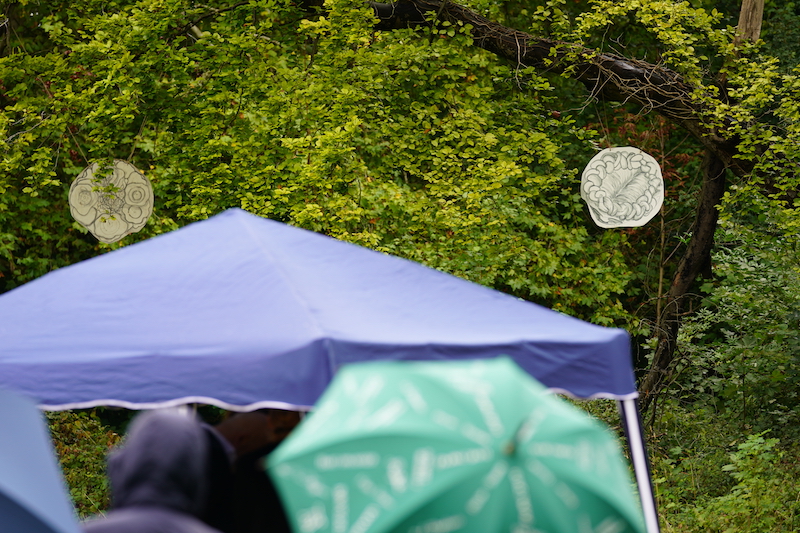Scroll down for English
Auswilderndes Blau: Vorschlag zum Umgang mit der sterbenden Rotbuche an der großen Wiese im äußeren Schlosspark: Wir möchten den alten Riesen stehen lassen, den überflüssig gewordenen Zaun abbauen und die Pfähle wieder verwenden. Sie werden Teil eines Bannkreises, den Margit Czenki aus Poesie, blauen Blumen und Bändern um den Baum herum legt.
Offene Wiesen, wie die im äußeren Schlosspark, stehen im romantischen Landschaftsgarten für Demokratie und Freiheit, für Rousseau’s „Zurück zur Natur“, erinnern an die Commons und die Allmende. Mauern und Zäune werden in Gärten dieses Typs um jeden Preis vermieden.
Doch ausgerechnet diese zentrale Wiese wird von einem Zaun durchschnitten. Der gestalterische Missgriff zerstört die Ablesbarkeit der historischen Gartenanlage und deren Erlebbarkeit.
Als Grund für diesen massiven Eingriff wird die fehlende Standsicherheit dreier alter Bäume angeführt. Die drei Bäume hatten in den Nullerjahren abgesägt werden sollen. Nur durch den Einsatz einer Bürger*inneninitiative konnten diese Fällungen damals verhindert werden.

Diese grundsätzliche politische Auseinandersetzung und Entscheidung wird im partizipatorischen Verfahren des Parklabyrs selbstverständlich nicht in Frage gestellt oder neu aufgerollt – weil selbstorganisierte politische Prozesse das Wichtigste an der Demokratie sind.
Doch wird aus unserer Sicht der politische Erfolg etwas getrübt durch den dominanten Zaun, der gar nicht notwendig ist.
Denn auch anderswo in Leverkusen gibt es alte Bäume. Deren Standfestigkeit wird, anders als im Schlosspark, alljährlich geprüft. Das könnte, wie wir vom Fachbereich Stadtgrün wissen, genau so auch im Schlosspark geschehen. Dies sollte umgehend umgesetzt werden.
Ein temporäres Monument als lebendige Welt – Auswilderndes Blau
Wirklich einsturzgefährdet ist zur Zeit nur einer der Bäume, diese bereits zu zwei Dritteln abgestorbene Rotbuche – und das auch erst seit Kurzem. Der Jahrhunderte alte Baum war noch vor 4 Jahren, vor Beginn der Dürre, durchgängig vital.
Diesem Baum haben wir zusammen mit dem Barockensemble L’Art Del Mondo im September 2022 das Requiem Hummings for a dying Tree, und dünne, ausgesägte, vergängliche Holzmedaillons gewidmet.
Doch wie weiter mit Baum und Absperrung umgehen?
Der aus Naturschutzsicht radikalste Vorschlag will den Dreihundertjährigen stehen lassen. Denn: Herumstehendes Totholz steigert die Biodiversität als Lebensraum für Pilze, Insekten und (zum Beispiel) Spechte.
Aber auch die besorgniserregende Tatsache, dass ein so alter Baum nach wenigen Jahren der Dürre im Zuge des Klimawandels verdurstet, ist es wert, sichtbar zu bleiben. Wie eine Ruine im romantischen Garten stünde der Baum für eine Verbindung zum Wissen der Vergangenheit.
Doch anders als in den stark auf die Produktion von natürlich-eleganten Bildern konzentrierten Romantik geht es in dieser Arbeit um eine Kooperation mit Naturkräften und anderen Spezies:

Um den Bereich um den Baum hervorzuheben und zu markieren wird ein weiter Kreis blau blühender Waldrand- und Wiesenblumen gepflanzt. Die alten Zaunpfähle werden getrocknet, verrottendes Holz entfernt, in blau gefärbt und dann wieder verwendet. Die Blautöne als Referenz an die erste industrielle Farbproduktion in Leverkusen, der Baum und die natürlichen Prozesse als „welterzeugende“ Praxen, wie es Anna Tsing nennt, werden verwoben durch breite Bänder, die die Künstlerin mit einem Songtext besticken wird, und die den gesamten Bereich um den Baum symbolisch als Bannkreis kennzeichnen werden.
Mit der Zeit werden die Äste des Baumes und Christoph Schäfers Baumscheiben (siehe Foto unten) abfallen, der Zaun zunehmend überflüssig und abgebaut. Die Blumen vermischen sich mit der Zeit wie ein auslaufender Farbverlauf mit der Wiese. Teile des Baums beleben sich wieder oder werden endgültig zu Humus. Das Werk löst sich im Naturkreislauf auf.
Margit Czenki, Christoph Schäfer

OUTWILDING BLUE
A proposal for dealing with the dying copper beech on the large lawn in the outer park of the castle: we would like to leave the old giant standing, take down the fence that has become superfluous and reuse the posts. They will become part of a spell circle that Margit Czenki will place around the tree made of poetry, blue flowers and ribbons.
Open meadows, like those in the outer castle park, stand for democracy and freedom in the romantic landscape garden, for Rousseau’s „back to nature“, remind us of the commons. Walls and fences are avoided at all costs in gardens of this type.
But this central meadow, of all places, is cut through by a fence. This design error destroys the readability of the historic garden and its experience.
The reason given for this massive intervention is the lack of stability of three old trees. The three trees were to have been cut down in the noughties. Only the efforts of a citizens‘ initiative prevented the felling at that time.
This fundamental political debate and decision is of course not questioned or re-opened in the participatory process of the Parklabyr – because self-organised political processes are the most important thing about democracy.
But from our point of view, the political success is somewhat clouded by the dominant fence, which is not at all necessary.
Because there are also old trees elsewhere in Leverkusen. Their stability, however, is checked every year, unlike in the Schlosspark. As we know from the Department of Urban Greenery, this could also be done in the same way in the Schlosspark. This should be implemented immediately.
A Temporary Monument as a Living World – Outwilding Blue
At present, only one of the trees is really in danger of collapsing, this copper beech, two-thirds of which is already dead – and that only recently. The century-old tree was still vital throughout 4 years ago, before the onset of the drought.
Together with the baroque ensemble L’Art Del Mondo, we dedicated the requiem Hummings for a dying Tree, and thin, sawn-out, ephemeral wooden medallions to this tree in September 2022.
But what to do with the tree and the barrier?
From the point of view of nature conservation, the most radical proposal is to leave the three-hundred-year-old tree standing. After all, standing deadwood increases biodiversity as a habitat for fungi, insects and (for example) woodpeckers.
But the worrying fact that such an old tree dies of thirst after a few years of drought in the wake of climate change is also worth keeping visible. Like a ruin in a romantic garden, the tree would stand for a connection to the knowledge of the past.
But unlike Romanticism’s strong focus on the production of naturally elegant images, this work is about a cooperation with natural forces and other species:
To highlight and mark the area around the tree, a wide circle of blue-flowered forest edge and meadow flowers are planted. The old fence posts are dried, rotting wood removed, dyed blue and then reused. The blue tones as a reference to the first industrial colour production in Leverkusen, the tree and the natural processes as „world-generating“ practices, as Anna Tsing calls it, will be interwoven by wide ribbons that the artist will embroider with a song text and that will symbolically mark the entire area around the tree as a banishing circle.
Over time, the branches of the tree and Christoph Schäfer’s tree discs (pictured above) will fall off, the fence increasingly superfluous and dismantled. In time, the flowers will blend with the meadow like an expiring colour gradient. Parts of the tree revive or finally become humus. The work dissolves in the cycle of nature.
Margit Czenki, Christoph Schäfer
Parklabyr, Museum Morsbroich, September 2022, kontakt@parklabyr.de

